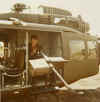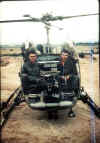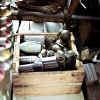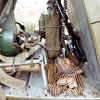
R. Robinette & J. Perry
LZ English, 1968 - by R. Robinette

LZ Mustang, An Lo Valley, late 1967 - by F. Vanatta
... STICKS and STONES and OTHER WEAPONS ...
COMMAND & CONTROL
The types of weapons carried by the crews in the UH-1's were normally very basic. These would mainly consist of a knife plus the usual pistol of some calibre. The lack of space to store extra weapons of choice kept the list of personal weapons relatively small.
The UH-1 itself usually carried two 7.62mm M60 type machine guns, one mounted in each two-man compartment on the sides of the helicopter. These were operated by the crew chief and one other person who was assigned to that machine. These guns were swivel mounted on a fixed arm that was attached to the sides of the helicopter just below the sliding doors. The rifle type stock that was used by ground troops and the scout gunners was replaced by a side by side two-handed grip and a "butterfly" type trigger assembly.
This is the same system used on most of the "slicks" that transported troops throughout the war.
On occasion, a non-standard weapon would come along. One UH-1H had a .50 calibre gun installed at the door gun position.
 |
Emory with the .50 on
# 394
by C. McAllister
|
SCOUTS
OH-13
The scout helicopters operated in a more hostile environment when they were "at work", so it was not unusual for there to be a bit more in the way of personal weapons carried by the crews. While space was still at a premium, the types of weapons chosen were quite varied. Besides the usual knife and pistol carried by most aircrew, one could find items that progressed from the earlier M2 carbine to the later M16 rifle or M79 grenade launcher, or even something as exotic as a Thomson sub-machinegun. In fact, the M16 could be neatly stowed in a muzzle down position just inside and forward of the door openings - very reminiscent of the scabbard hanging from the saddle of some earlier scouts in the Wild West. It was all very much a matter of personal choice as to what was carried.

|
F.
Vanatta - note M16's stowed forward of doorways
Stopping for lunch at Chu Lai on the move North, early 1968 - by F. Vanatta |
A number of grenades were also carried in the scout ships. These consisted of regular explosive, white phosphorus, incendiary, CS and four different colors of smoke. While most of these were carried in a .50 caliber ammunition container that was stored between the seats, others were often found hanging on the defroster cable or even on safety wire that was attached to some part or other of the firewall. It was a matter of choice of a particular crew as to where these were stored and how many they tried to get the poor old OH-13 to lift.
The pins on these grenades were bent apart so that they would not be pulled out if they snagged on anything while being handled. These would be straightened again when a grenade was selected for use, and the ring then pulled in the usual manner. While it was easier for the gunner to pull the pin with both hands available, the pilot could only have one hand free at any given time. The door hinge on the OH-13 made a very handy place for the pilot to hook the pin with his left hand so it could be pulled out easily. The crews became very proficient at lobbing a grenade into a small opening while flying past.
The observers in the scouts, later usually referred to as gunners, carried a hand held version of the M60 machine gun. Some gunners made their own personal modifications to this weapon to help them better the performance they got from it. This could be anything from modifying the tension of the trigger spring to cutting off the end of the barrel to aid in physically maneuvering the gun. The ammunition for the weapon was in a belt form, usually of about 800 rounds, laid out on the floor in front of the gunner.
While the pilot and gunner worked well as a team, each looking out after the other, they did unconsciously see things from a different perspective in the heat of the battle.
The gunner became a part of the aircraft and, from his point of view, controlled the elements of the contact. The helicopter was attached to his machine gun and he controlled it by the way he aimed the gun or with a few short audible commands over the intercom.
The pilot, also becoming a part of the aircraft, controlled the attack in his own way. The gunner became a part of the armament system of the helicopter, and the pilot brought fire to bear on the target by placing the gunner in the right position and also adding a few comments of his own.
However one tries to explain the situation, the scout crews formed a partnership that is very hard to explain to the uninitiated - and it worked!
There have always been many innovative "field modifications" made to various bits of equipment in any war, some of which were surprisingly simple. Things did not always work as well in the field as they did on the drawing board. An example of this was a fix for the ammunition belt feed jams that occurred with the M-60 machine gun. The normal ammunition feed chute that was designed to go onto the M-60 worked well when the gun was stationary. The problem arose when the gun was swung around when aiming it from the helicopter. It was discovered that the C-ration can that held ham & lima beans fit the clamps on the gun and provided the right angle for the feed. It was easy to find and fit, and it worked.
Like many of these field modifications, it is not known who discovered the solution or just when it came into being. All that is known is that these cans worked very well for a number of years until the "R" version of the M-60 came out with a newly angled feed ramp.
This item can be seen in the next couple of photos.

|
Larry
Emberton LZ Betty, mid 1968 - by Ed Holmes |
In the early 1960ís, the concept was conceived to arm the OH-13 with a pair of fixed machine guns. With this in mind, the U.S. Army developed a training group known as TIGER SCHOOL at Ft. Sill, OK. These "Tiger Classes" were intended to prepare the crews for low level reconnaissance, artillery adjusting and the use of a fixed gun installation. Both Ronald Ehmann and Al Smith attended this school before the 1st Cav left for Vietnam.
The initial installation, known as the XM1, consisted of two M37C .30 caliber machine guns, 500 rounds of ammunition per gun, plus a small air bottle which was used to recycle the guns when they jammed. The air bottle system proved to be very unreliable. This system was installed on the OH-13E which had an underpowered Franklin engine and wooden blades. This resulted in a very heavy helicopter, to say the least.
When the unit arrived in Vietnam all the OH-13ís they brought with them were the newer "S" model. Even though this model had more available power, the higher temperatures and density altitudes encountered in Vietnam left these helicopters just as short of power with the fixed gun system installed. These guns were not installed when the helicopters arrived in Vietnam in late 1965.
The initial mission profile for the "observation" helicopters in Vietnam was to adjust artillery or to move couriers around. Soon these helicopters began to "scout" ahead of the troops in the field or to check out areas to determine what enemy positions may be present for future U.S. missions. As these scouting missions put the helicopters more "in harmís way", they began to take more enemy fire. To help counter this situation, the observers began taking an M-60 machine gun with them and hand grenades also began to be taken along.
At some later date, possibly around mid 1966, the concept of a fixed gun system was revived. The new installation was known as M2, and now consisted of two M60C 7.62mm machine guns, 650 rounds of ammunition each, plus the charged pneumatic system. It is not recorded how effective this system was in actual use, but they were removed again in about April or May of 1967.

|
Billings & B. Medsker with fixed gun system
Note part of bubble missing after an argument with a dead tree during contact with an enemy position. LZ English, Bong Song, early 1967 by B. Medsker |
The following two photos are of an OH-13 belonging to the HHC, 2nd Brigade. These were taken at LZ English in the Bong Song area in 1967 by Steve Rocket of an aircraft flown by him.
On behalf of the members of the Flying Circus, the author would like to thank Michael Law for granting permission for these photos to be used in this article. Michael was the Directory Editor for the Vietnam Helicopter Pilots Association at the time this article was written, and he obtained permission from the VHPA for these photos to be used here.
 |
There was one special OH-13 that existed for a brief period of time around June of 1968. Clay Greager took two tubes out of a normal bank of five rockets, mounted the remaining three tubes inside the left skid, and produced a system to arm, select, and fire each rocket. Frank Vanatta flew the first trials of this combination, and he and Clay successfully flew this version for a couple of weeks before some Colonel spotted it parked on the ready line at Quang Tri. Word soon came down "from on high" that this would not work and that the instillation would be too heavy. The unit was instructed to remove the rockets. Frank and Clay dubbed this helicopter "the pink team" - it was more than just a scout team (white) and not quite artillery or guns - (red).
It should be noted that the term "pink team" was used in a tongue in cheek manner by those in the unit during the existence of this combination. It was later used officially to denote the hunter - killer team of one OH-6 Cayuse and one AH-1 Cobra that several aviation sections used.

|
F. Vanatta & rocket equipped Sioux
LZ Betty, 1968 - by F. Vanatta |
HISTORICAL TRIVIA :
In 1963, the Bell Helicopter Company developed a more heavily armed version of the OH-13. This was their model 207, and was known as the Sioux Scout. The crew of two were seated in tandem, with the gunner in the front and the pilot seated behind him. The pilot gained access to the cockpit through a door on the left side while the nose section of the helicopter hinged open for the gunner. A twin gun system was mounted in a turret below the nose which was operated by the gunner. The fuselage and tail boom were covered with a metal skin much like the Bell 47J Ranger and the fuel tanks were internal. A set of small wings with external mounting points completed the transformation. The rotor system appeared to remain the same. The Army did not proceed with the type. It would be another few years before the concept was tried again by Bell, this time turning the UH-1 Huey into the famous AH-1 Huey Cobra. One can only speculate what it would have been like to take that version of the OH-13 into combat in those days.
| submitted by F. Vanatta |
OH-6
The types of personal weapons did not change much with the introduction of the OH-6, though there was now more room for the gunner to carry things. This extra room plus the added power of the OH-6 meant that the gunner could now carry more ammunition, and the standard load was increased to 1000 rounds.
Though different units put the gunner in different locations, in the Flying Circus helicopters he occupied the right rear seat. The reasons behind this choice were that the left front seat would have been more cramped than the area he had in the OH-13, it gave him more room for the equipment he carried, and it meant that he did not have to vie with the mini-gun for a view out of the left side of the machine.

|
 |
 |
 |
|
C. Greager & Ed Holmes in an OH-6.
LZ Betty, 1968 - by B. Potvin |
Some of the small arms
carried by the scouts.
by R. Grossmann |
Various types of hand
grenades.
by R. Grossmann |
The scout gunner's
office.
by R. Grossmann |
With the introduction of the OH-6, came the return of an externally mounted gun. The new weapon was the six barrel, 7.62mm, M134 Gatling gun - known as the "Mini-gun". This gun was fired by the pilot, and had two main speeds. The first speed fired 2000 rounds per minute, while the second speed jumped the rate up to 4000 rounds per minute. There was a three second interrupter on the system to help keep the barrels from overheating. This weapon was mounted on the left side of the helicopter, just outside the left main door. The ammunition container, holding about 2500 rounds, rested across part of the back area just behind the wall separating the front from the back of the helicopter. The gun could be electrically moved up and down over a limited arc in relation to the aircraft body, and a small sighting oval on the end of an arm (the XM70E1 sight) moved up and down in front of the pilot with the movement of the gun. Most pilots used this sight to put the gun at an elevation they were happy with and then moved the sight out of the way to the side. The helicopter was so responsive in flight that it could be maneuvered to adjust the tracers onto the target faster than trying to first line up the target using the sight.
Everyone on both sides took notice when the mini-gun was fired from what had originally been perceived as "such a small helicopter".

|
 |
| The M134 Mini-gun system
by W. Sullivan |
Mini-gun installation on an OH-6 ; Ed Holmes' good luck charm
by Ed Holmes |
Mini-gun firing -- inland of Quang Tri, 1968
by F. Vanatta |
Mini-gun, up close
by R. Grossmann |
In about February of 1970, while the unit was still working out of Tay Ninh, Mike Foster thought it would be good to have a set of rockets installed on an OH-6. The idea looked good "on paper", so Keith Zuhlke and Tony Wassmer added a rocket pack to the left side of a Cayuse and built a switching system for selecting and firing the rockets. Mike and Ken Gardiner took the helicopter out a couple of times to test the unit, and the combination was used several times before the helicopter returned one day with a badly pitted bubble. Rumor has it that there were no other volunteers to fly that OH-6 after that. Though there were times when the rockets were quite effective, it was felt that the mini-gun was better when a quick response was needed. This combination suffered the same fate as the one installed on the OH-13 in 1968.
|
rocket equipped Cayuse at Tay Ninh, early 1970
by K. Zuhlke |
information submitted by R. Ehmann, K. Gardiner, C. Greager, B. Medsker, B. Potvin, Al Smith, W. Sullivan, K. Zuhlke and others
compiled by F. Vanatta